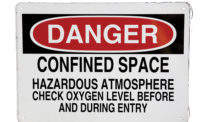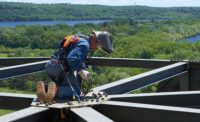Conducting a respiratory exposure assessment and utilizing the results to design an effective respiratory protection plan for a construction crew is a science. It can seem like a complicated science when you factor in everything that goes into developing and creating a respiratory protection plan: initial review of potential hazards, measurements, evaluation of those measurements, selection of controls, their implementation and assessment of their effectiveness, and other factors.
Despite the perceived complexity, every site should evaluate the respiratory protection needs of their crew. To make this process easier, the American Industrial Hygiene Association (AIHA) has published a five-part cyclic process to help guide an exposure assessment1.
This is only an overview of the exposure assessment process. A safety and health professional such as a Certified Industrial Hygienist (CIH) should be consulted for a more complete review of the process and assistance in its proper implementation2.
Background on the assessment
An exposure assessment allows companies to consider health risks that may potentially impact workers on a jobsite. A thorough assessment can help determine the acceptable and unacceptable exposures that exist so they can be documented and, if need be, controlled.
An exposure assessment includes five steps:
- Basic characterization
- Qualitative assessment and prioritization
- Exposure monitoring
- Interpretation and decision-making
- Recommendations and evaluation
Part 1: Basic characterization
A basic characterization is an inventory of all workers, tasks or processes, as well as contaminants and potential exposures. The goal of a basic characterization is to evaluate and/or characterize a workplace or jobsite to identify any potential exposures workers may face.
This phase of the process allows companies to sort out all the puzzle pieces: the workforce, agents (whether chemical, physical or biological) and similar exposure groups (SEG) – workers expected to have similar exposure levels to a given contaminant. It includes the documentation of each classification of worker who may be exposed along with the number of employees in each group.
Next, a basic characterization considers the properties and impact of any existing agents – for example, whether they could cause acute, short-term effects (such as hydrogen sulfide exposure) or long, delayed effects (such as loud noise).
Part 2: Qualitative assessment and prioritization
A qualitative assessment includes an exposure rating based on past monitoring, professional judgment and possibly exposure modeling (i.e. mathematical calculations to estimate potential exposure levels). The Well Mixed Room Model is an example of exposure modeling.
This assessment should also rank the groups by considering the adverse health effects of overexposure along with whether they are chronic or acute, and reversible or irreversible.
A possible exposure rating process using a two-dimensional matrix of estimated exposure level and adverse health effects may include:
- Exposure rating from 0-4, with 0 indicting no exposure and ranging up to 4, indicating very high exposure; and
- Adverse health effects rating from 0-4, with 0 indicating no or minimal expected adverse health effects and ranging up to 4, indicating irreversible, possibly life-threatening effects.
Part 3: Exposure monitoring
The goal of exposure monitoring is to determine actual worker exposures and identify the crucial sources of exposure for future control. Exposure monitoring needs to consider all routes or pathways of exposure, whether it is airborne and could be inhaled, or on a work surface and could be touched and absorbed through the skin.
The objective of the monitoring needs to be determined ahead of time to ensure the samples collected provide the information needed. Monitoring objectives may be:
- Baseline monitoring – to determine worker exposure and assess the current work situation (i.e. do we have an over exposure to lead?).
- Diagnostic – to identify sources of contaminant release to aid in developing control measures (e.g. determining which tasks are generating the most lead exposure to the workers).
- Compliance – to comply with regulatory requirements (e.g. to comply with exposure assessment regulations in 29 CFR 1926.62 Lead in Construction).
Exposure monitoring methods, depending on the objective, typically include:
- 8-hour, time-weighted average monitoring
- Short-term, 15-minute exposure monitoring
- Task-based monitoring
- Direct reading monitors and/or
- Wipe samples
Part 4: Interpretation and decision-making
The goal of this phase is to evaluate all data and make decisions about which exposures are acceptable and which must be addressed. Acceptability can be based on professional judgment, analysis with statistical tools, regulatory requirements or a combination of all three. Typically exposure limits such as the OSHA Permissible Exposure Limits (29 CFR 1926 or 29 CFR 1910) (PELs) or the American Conference of Governmental Industrial Hygienists Threshold Limit Values (TLVs) are used to help assess and interpret monitoring results.
There are three possible outcomes:
- Exposures are acceptable and will be reevaluated at a future date.
- Exposures are unacceptable and control measures need to be implemented.
- There is insufficient data to make a decision, in which case further investigation (possibly more exposure monitoring) is necessary.
Part 5: Recommendations and reporting
The final phase is primarily about establishing and maintaining good records of exposure conditions and actions taken. By doing so, companies create a baseline for future assessments and help document regulatory compliance. As a result, all reports should be completed in a timely manner and should be routed to management. In some regulations, such as the new silica regulations (29 CFR 1926.1153), OSHA also requires employees be notified of any exposure assessment results and what actions will be taken based on those results.
The final report should include an executive summary. The executive summary should be a one-page synopsis that covers the big picture issues — purpose, contaminants, results and recommendations.
Exposure results per OSHA should be retained a minimum of duration of involved workers’ employment plus 30 years.
Conclusion
Once an exposure assessment is complete and any controls are implemented, another assessment should be made to document that the controls have adequately addressed any problem areas. If exposures were determined to be acceptable, a future date should be set to reassess exposures to help ensure any changes in materials, processes, equipment, regulations or new information on health effects have not altered the workers’ exposure acceptability.
Worker exposure assessment is a cyclical process of characterization, assessment and prioritization, exposure monitoring, interpretation and decision making, implementing controls and reassessing as conditions change. Through this process, safety professionals can maximize the effective use of resources to protect worker health and safety.
References
- A Strategy for Assessing and Managing Occupational Exposures. 4th Ed. 2015 AIHA Press, www.aiha.org
- American Board of Industrial Hygiene (ABIH), www.abih.org


